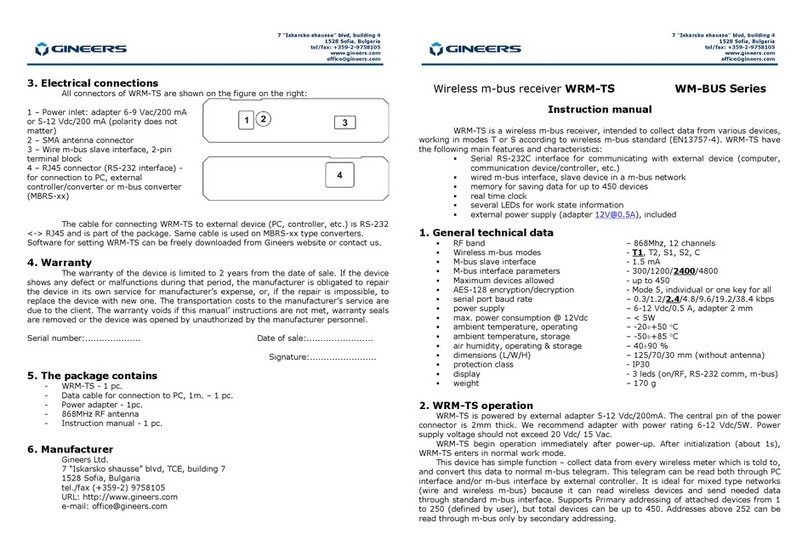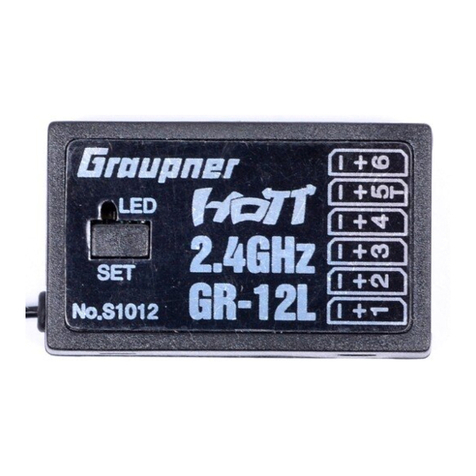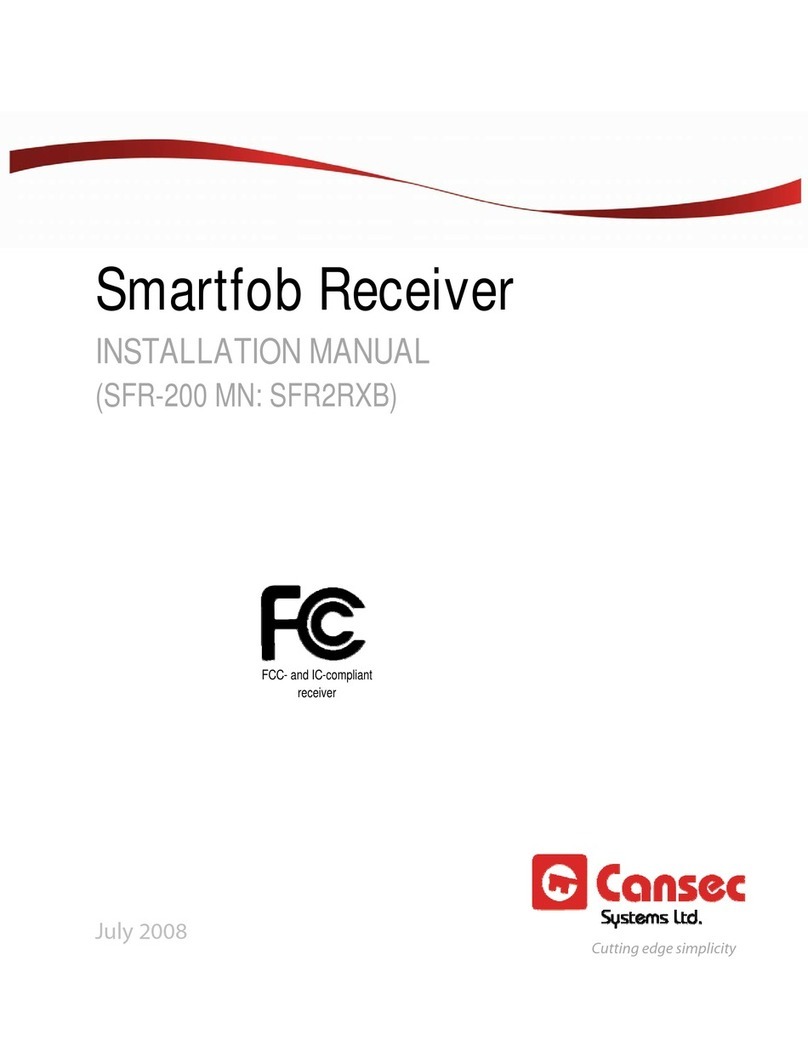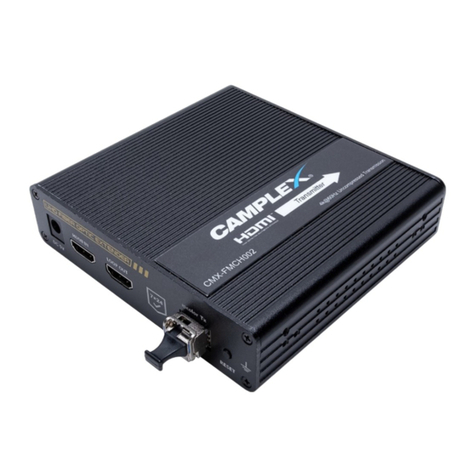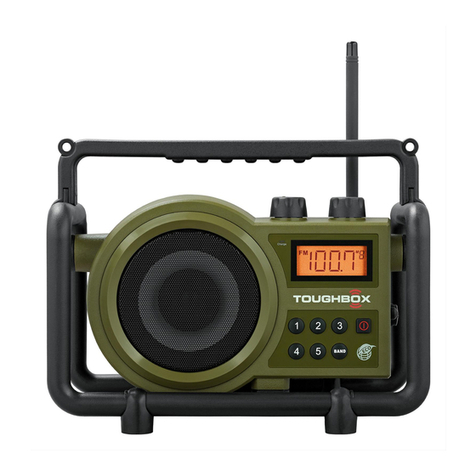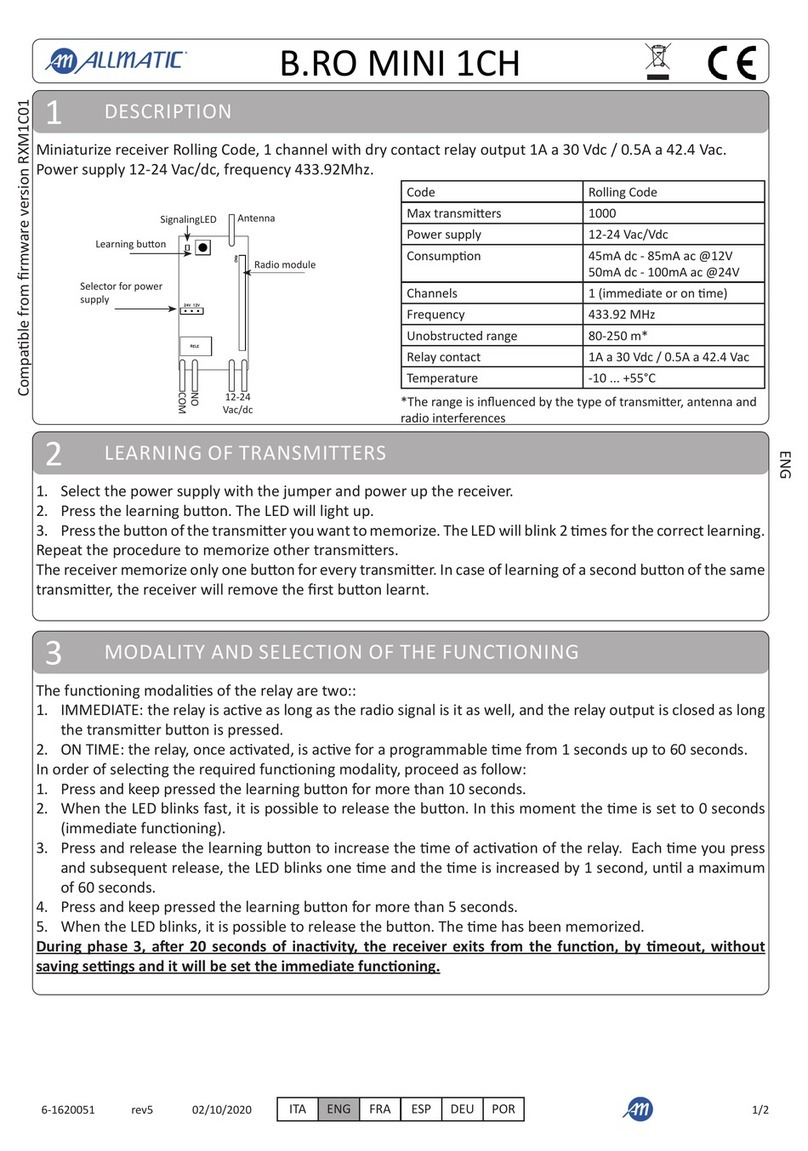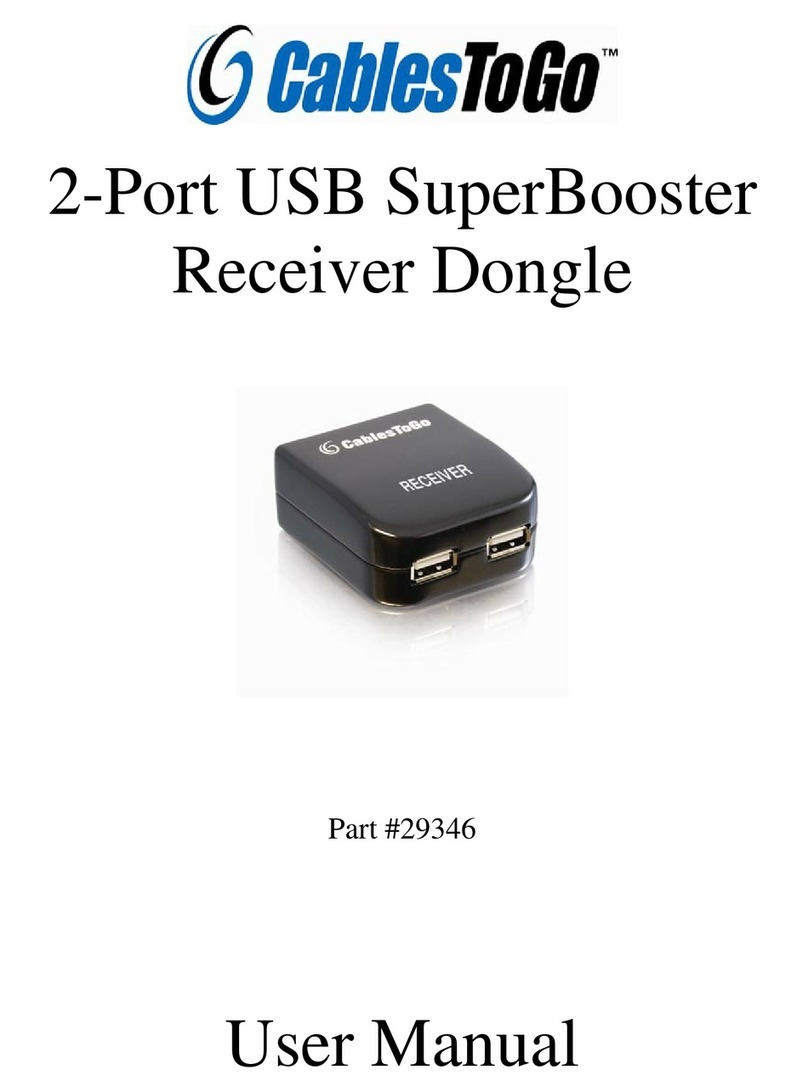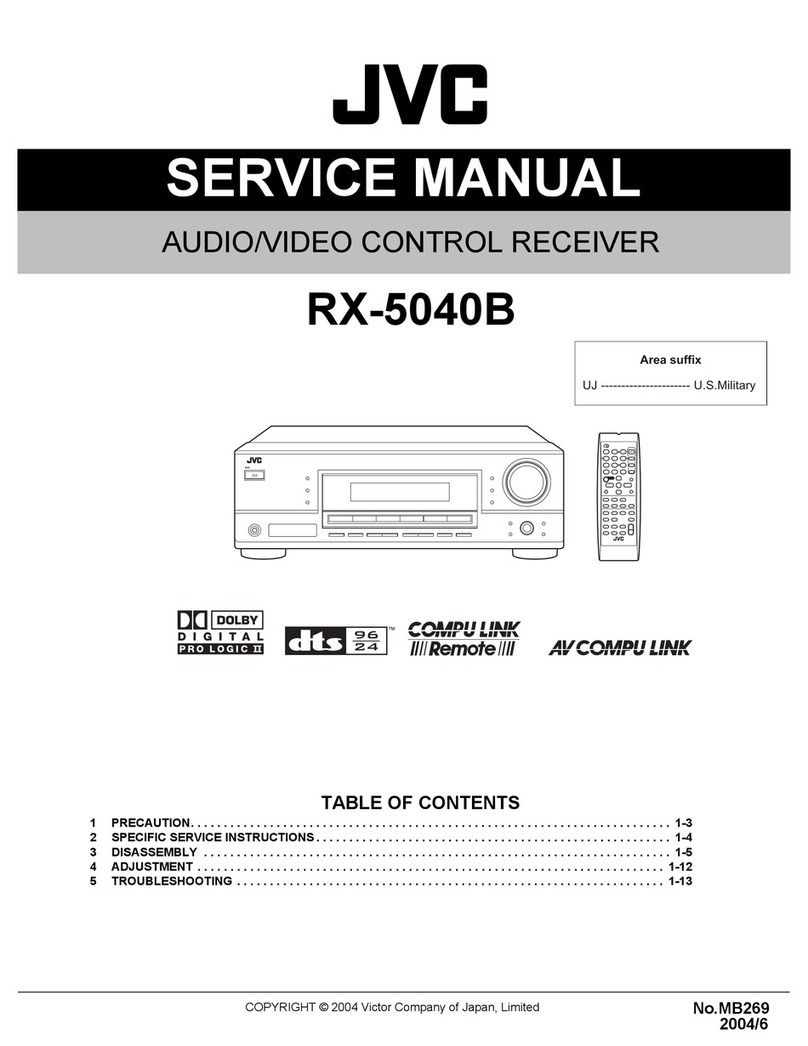GINEERS WRMnano User manual

___________________________________________________________________________________
WRMnano User Manual page 1/18
WIRELESS RECEIVER WRMnano
U S E R M A N U A L
Rev. 0.2a

___________________________________________________________________________________
WRMnano User Manual page 2/18
TABLE OF CONTENTS
1. General description 3
2. Technical parameters 5
3. Wired m bus telegrams and setting the device 5
3.1. M-bus telegrams description 5
3.1.1. Standard readout m-bus telegram 5
3.1.2. C anging Primary address of an activated meter 7
3.1.3. M-bus setup telegrams for WRMnano 8
3.1.4. WRMnano respond on commands - RECEIVE DATA sub-telegrams 9
Examples 10
4. Using GINEERS software to set WRMnano 11
4.1. Activate/Delete exact meter ID in WRMnano 12
4.2. Deleting all devices from WRMnano memory 13
4.3. Set AES-128 key for eac activated meter 13
4.4. Turn On or OFF WRMnano flags and corresponding functions 13
4.5. Set up to 8 filters for eac FILTER activated 15
4.6. C ange Primary address of desired logical meter 15
Hints using program 16
5. Quick start guide
6. Contacts 14

___________________________________________________________________________________
WRMnano User Manual page 3/18
1. General description
WRMnano is a device, w ic translates OMS wireless m-bus messages to wired
m-bus. It receives wireless m-bus messages and saves t em in its internal memory. It
can save data for up to 64 wireless devices. T en it can relay data for any saved
wireless device upon request wit valid wired m-bus telegram (usually REQ_UD2). It
is powered entirely by m-bus, t us assisting easy mounting and best possible
placement.
If more t an 64 wireless m-bus devices must be relayed to wired m-bus, t en
several WRMnano devices s ould be employed, all on t e same m-bus interface. In
t is case user s ould take care to set different Primary addresses bot to WRMnano
devices and integrated meters, if reading is to be made by Primary addresses.
Eac WRMnano as its own Primary address (settable by user) and unique
Secondary address - WRMnano serial number. T ey are used w en programming
WRMnano suc as activating/deleting new meters in its memory, saving AES-128 key
for desired meter and so on.
All wireless messages from different meters are saved in WRMnano internal
memory, based on t eir identification number (ID). T ere are two modes of WRMnano
operation:
o automatic mode – in t is mode automatic activation is implemented. W en
WRMnano receives valid wireless m-bus message, it activates t e ID of t e
device, (if not already activated), saves t e message in its internal memory,
and updates it upon eac reception. It is done until t e maximum 64
devices are activated. T en only messages are updated upon eac new
reception. Eac new device will ave Primary address of 0;
o manual mode – t e IDs of t e wireless m-bus devices t at s ould be read
must be manually activated in t e WRMnano memory. T is way WRMnano
saves only t e messages from t e already activated devices and ignores all
ot er radio messages. T is activation is made t roug m-bus interface and
since its wit manufacturer specific telegrams user s ould use our software
for t is or implemented commands in is own system. M-bus telegrams are
described furt er in t is document.
T e saved telegrams from t e wireless devices can be accessed via standard
readout m-bus command, s ort telegram (REQ_UD2). Activated radio devices wit in
WRMnano memory act as separate logical wired m-bus devices, eac wit its own ID
and primary address. T e ID is t e same as t e one of t e wireless device, and t e
primary address can be set by (and c anged any time) t e master. T e default value
for primary address, as mentioned above, is 0. WRMnano as its own ID and primary
address, and all commands to t e device (activation/deletion of RF device, work mode
selection, setting various options) s ould be send to t is address. By default device is
set wit Primary address 249.
WRMnano also supports mode 5 AES-128 decryption of t e received wireless m-

___________________________________________________________________________________
WRMnano User Manual page 4/18
bus messages, and if decryption is enabled and correct key(s) is/are programmed, it
can decrypt wireless m-bus telegrams. T e user can set separate key for eac
activated device and if t e data is encrypted, WRMnano would decrypt it. For now
t ere is no possibility to use one key automatically for all devices, but programming
same key for all meters wit our software is easy to do and does not take muc time.
In addition, WRMnano as special filter capabilities, w en operates in automatic
mode. T is means t at user can limit automatic activation to meters of interests. T is
is useful in many cases, because in most of t e cases t ere are meters t at do not
belong to network of interest, but anyway are read due to interference.
T ere are t ree different FILTER masks t at can be activated:
filter meters by manufacturer identification - for instance GIN
filter meter by serial number ID, using wildcards in serial number (eg.
1234FFFF)
filter meters by medium measured - for instance activated only water and
eat meters
Eac filter type as up to 8 different values t at can be saved and used. T is
means t at if user decides to filter wireless m-bus meters by manufacturer, e can
'tell' WRMnano to activate automatically only "GIN", "SON" and "BMT" meters, for
instance. Same applies for medium and serial number mask. In many cases t is can
save time w en setting WRMnano on site.
WRMnano as internal clock, w ic can be set to real time. It is not energy
independent, so if m-bus power supply fails t en new setting of RTC s ould be made.
As an option user can set WRMnano to add timestamp to eac wireless meter
telegram. T is timestamp t en can be used to know w en particular meter as been
read for last time. Timestamp is coded as standard m-bus telegram, data type F.
And last, WRMnano can provide RSSI data in manufacturer specific part of eac
telegram, if programmed to do t at.

___________________________________________________________________________________
WRMnano User Manual page 5/18
2. Technical parameters
Parameter
Value
m-bus voltage 24 to 40V
m-bus current draw Up to 7.5mA (5 std. M-bus loads)
antenna connector SMA-F
number of meters read Up to 64
wireless m-bus modes T and S
AES-128 encryption Yes, CBC, Mode 5
status info Multicolor led
dimensions (w/o antenna) x/x/x mm
IP protection IP30
working temperature 0 to +40 0C
storing temperature -10 to +50 0C
own weig t 20 g
3. Wired m bus telegrams and setting the device
All settings of WRMnano (adding or deleting ID, setting filters, saving AES-128
keys) are made via m-bus interface and manufacturer specific. To do t at user s ould
ave standard transparent m-bus converter, we suggest using MBnano-10 ().
WRMnano as its own primary and secondary address t at s ould be used to make
settings.
Wireless meters/messages can be read via standard m-bus readout telegrams
(SND_UD/RSP_UD). Bot primary and secondary addressing is supported. SND_NKE
is supported too.
T e primary addresses of t e logical devices (eg. meters activated) can be set
via standard m-bus telegrams. Standard procedure is to select t e logical device by its
secondary address, t en set primary address, t en deselect t e device. T is can be
done not only wit our software, but wit any compliant m-bus software.
If two or more logical devices are set wit t e same primary address, t is would
result in collision w en trying to read any of t em by primary address. Secondary
addressing is supported too, so user can read also all devices by secondary address,
searc by ID mask and so on.
3.1. M bus telegrams description
3.1.1. Standard readout m bus telegram for logical device/meter
User can read eit er via Primary address s ort telegram:
0x10 0x5B/0x7B A CHK 0x16
or by selecting device via secondary address. T en meter of interest will start to

___________________________________________________________________________________
WRMnano User Manual page 6/18
respond on Primary address 253 (0xFD).
T e response from WRMnano of t e standard s ort-frame readout command is
somet ing like t is:
0x68 L L 0x68 C A CI DATA CHK 0x16
w ere:
0x68 and 0x16 are start/stop bytes
L is lengt of t e telegram according to EN 13757-3
C, A, CI are respectively C-field, primary address and CI-field
CHK is c ecksum of t e telegram, according to EN 13757-3
DATA is user data, including eader and t e payload
HEADER (12 bytes fixed lengt ) DATA PAYLOAD
Header is 12-byte fixed lengt , t en t e data comprises of t e wireless
message and several option fields, if enabled. T ese fields may include timestamp of
t e message and RSSI of t is particular message.
Header format is as follows
ID MFR Version Medium Access No Status Signature
4-byte BCD 2 byte 1 byte 1 byte 1 byte 1 byte 2 byte
ID is t e 8-digit ID of t e wireless m-bus device
MFR is t e manufacturer of t e device, encoded in 3 letters, copied from Wireless m-bus
telegram
Version – t is is t e firmware revision of t e device, copied from Wireless m-bus telegram
Medium – medium of t e device, copied from Wireless m-bus telegram
Access No – transmit count of t e device, rollover @ 255; copied from Wireless m-bus
telegram
Status – Status, copied from Wireless m-bus telegram
Signature – signature, copied from wireless m-bus telegram, wit one exception – if
decryption is enabled and t e message is decrypted, all encryption fields are deleted to notify
t e master t at t e message is no longer encrypted.
Data payload is formatted as follows:
Wireless m-bus message Timestamp (option field) RSSI (option field)
Variable lengt 6 bytes 2 bytes
Wireless m-bus message is copied wit out any c anges, as received from t e meter.
Timestamp is added only if enabled, t is is t e time & date of t e last message
reception from t e device wit t is selected ID. T e clock of t e timestamp is t e
internal clock of t e WRMnano. T e timestamp format is as follows:
0x04 0x6D TIMEPOINT
DIF VIF Standard 4-byte time&date m-bus format, data type F

___________________________________________________________________________________
WRMnano User Manual page 7/18
RSSI is added only enabled, it consists of 2 bytes:
0x0F RSSI
MFR-specific DIF RSSI in -[dBm]
3.1.2. Changing Primary address of an activated meter in WRMnano
Eac device activated in WRMnano - eit er manually or automatically, in t e
beginning as Primary address 0. If user plans to read meters from WRMnano
memory via Primary address commands, t en eac logical meter s ould ave unique
Primary address to be read from.
T is follows strictly EN 13757-3 and m-bus standard, so is out of scope of t is
document. In general, ere are t e steps t at software s ould do:
- select meter of interest by Secondary address
- c ange Primary address of t e selected meter
- de-select meter
T e above can be accomplis ed wit our free software or any m-bus software
t at follows t e standard.
3.1.3. M bus setup telegrams for WRMnano
T ese telegrams must be sent only to t e WRMnano'w own m-bus address.
Send telegram format (master to slave and slave to master):
0x68 L L 0x68 C A CI SEND DATA/RECEIVE DATA CHK 0x16
0x68 and 0x16 are start/stop bytes
L is lengt of t e telegram, according to EN 13757-3
C – C-field (0x53 is C-field in master to slave direction, 0x08 in slave to master direction)
A is destination primary address - i.e. t e WRMnano primary address
CI – CI-field (0x51 is CI-field in master to slave direction, 0x72 in slave to master direction)
CHK is c ecksum of t e telegram
WRMnano can respond eit er wit confirmation c aracter (E5), or full readout
telegram.
SEND DATA sub telegrams
Set current time/date
0x04 0x6D TIMEPOINT
DIF VIF Standard 4-byte time&date m-bus format, data type F
Purpose: set internal clock of WRMnano to current datetime

___________________________________________________________________________________
WRMnano User Manual page 8/18
Activate new RF ID
1 2 3 4 5 6 7 8
DIF VIF VIFE - B0 B1 B2 B3
0x0F 0xFF 0x01 0x04 ID0 ID1 ID2 ID3
Purpose: Activates in WRMnano memory wireless m-bus device wit t is ID. ID is coded as in
m-bus standard.
Delete activated RF ID
1 2 3 4 5 6 7 8
DIF VIF VIFE - B0 B1 B2 B3
0x0F 0xFF 0x81 0x04 ID0 ID1 ID2 ID3
Purpose: Deletes wireless m-bus device wit t is ID from WRMnano memory. T is command
also deletes t e primary address of t is device (sets it to 0), but only if in automatic mode.
Selection of activated RF IDs
1 2 3 4 5 6 7 8
DIF VIF VIFE - B0 B1 B2 B3
0x0F 0xFF 0x02 0x04 POS NO 0 0
Purpose: to read activated devices in WRMnano memory more quickly. Master request
readout of activated IDs, starting from position [POS] (1 to 64), and expects to read [NO] Ids
(max 24, t ere is no more space in t e telegram). POS does NOT relate to meter's Primary
addresses, t is is internal organization of activated meters in WRMnano memory.
Delete activated RF IDs by position
1 2 3 4 5 6 7 8
DIF VIF VIFE - B0 B1 B2 B3
0x0F 0xFF 0x82 0x04 POS NO 0 0
Purpose: to delete activated meters i WRMnano wuickly, or to delete all memory wit one
command instead eac meter one by one. Master requests WRMnano to delete [NO] activated
RF-devices, starting from position [POS]
[NO] – 1 to 64, [POS] – 1 to 64
Again, POS does NOT relate to Primary address of meters, its t e internal order of activated
meters in WRMnano memory.
Set/Clear WRMnano flag
1 2 3 4 5 6 7 8
DIF VIF VIFE - B0 B1 B2 B3
0x0F 0xFF 0x05 0x04 FLAG # S/NC 0 0
Purpose: to enable/disable various options of WRMnano operation.
Sets (B1 = 1) or clears (B1 = 0) selected flag number (FLAG#).
List of implemented flags and t eir function:
Flag # Flag bitfield
Flag description

___________________________________________________________________________________
WRMnano User Manual page 9/18
1 0x0001 Auto mode (auto activates eac new received device ID until memory
full)
2 0x0002 Return timestamp it t e back of t e telegram
3 0x0004 Return RSSI at t e back of t e telegram
4 0x0008 Automatically decrypt telegrams wit saved AES-128 key
5 0x0010 Decode Apator telegrams and make t em into standard m-bus
6 0x0020 Decode Tec em telegrams and make t em into standard m-bus
7 Enable filter by Manufacturer
8 Enable Filter by Medium
9 Enable Filter by ID
Set AES key for specific RF ID
1 2 3 4 5 6 7 8 9 10 11 ... 24
DIF VIF VIFE - B0 B1 B2 B3 B4 B5 B6 ... B19
0x0F 0xFF 0x0A 0x14 ID0 ID1 ID2 ID3 AES0 AES1 AES2 ... AESF
Purpose: Sets [AES0-F] - 16 bytes HEX as AES-128 key for decryption of t e messages if t e
device wit ID [ID0-3]. ID is coded as in m-bus standard.
Requests to read t e AES key for specific ID
1 2 3 4 5 6 7 8
DIF VIF VIFE - B0 B1 B2 B3
0x0F 0xFF 0x8A 0x04 ID0 ID1 ID2 ID3
Purpose: to read AES key for logical device wit exact ID [ID0-3]. ID is coded as in m-bus
standard.
3.1.4. WRMnano respond on commands RECEIVE DATA sub telegrams
Eac command sent to WRMnano as a response - eit er telegram wit long
eader or just ACK (0xE5). T ese telegrams give info on command success/failure
and general data for a WRMnano. T ey are described in details below.
General info for wireless devices – returned at eac s ort telegram readout
1 2 3 4 5 6 7 8
DIF VIF VIFE - B0 B1 B2 B3
0x0F 0xFF 0x06 0x04 DEVN DEVR MAXDEV 0
DEVN – currently active wireless devices
DEVR – currently read device number (at least one valid telegram received)
MAXDEV – max. number for activated devices (fixed at 64)
Flag register data – returned at eac s ort telegram readout
1 2 3 4 5 6 7 8
DIF VIF VIFE - B0 B1 B2 B3

___________________________________________________________________________________
WRMnano User Manual page 10/18
0x0F 0xFF 0x05 0x04 FLAG0 FLAG1 FLAG2 FLAG3
Returns flag register as 32-bit value. Flag bits are represented as bitfields (see previous page)
RF device IDs return (RF device index 1 to 31)
1 2 3 4 5 6 7
DIF DIFE VIF B0 B1 B2 B3
b1m001100
b0000ssss 0x79 ID0 ID1 ID2 ID3
T ese IDs are returned on activated ID readout request
m:s encodes storage number (5 bits – bssssm), ssssm – current address index
ID0-3 – ID of t e RF logical device
RF device IDs return (RF device index 1 to 31)
1 2 3 4 5 6 7 8
DIF DIFE1 DIFE2 VIF B0 B1 B2 B3
b1m001100
b0000ssss
b0000ssss
0x79 ID0 ID1 ID2 ID3
T ese IDs are returned on activated ID readout request
m:s encodes storage number (9 bits – bssssssssm), ssssssssm – current address index
ID0 3 – ID of t e RF logical device
Read selected AES key
1 2 3 4 5 6 ... 20
DIF VIF VIFE - B0 B1 ... B15
0x0F 0xFF 0x8A 0x10 AES0 AES1 ... AESF
Returns AES-128 as 16 HEX bytes string.
Examples and further information
If t e device wit t is ID is not yet read over t e air, t e m-bus telegram is “empty” -
t ere is no manufacturer, no medium, no access counter, and data is empty.
Here is an example of trying to read activated device wit ID17063986 and primary address
10, w ic is not yet read:
68 0F 0F 68 08 0A 72 86 39 06 17 00 00 00 00 00 00 00 00 60 16
And t is is t e m-bus telegram for t e same device after it is read over t e air, wit
activated bot timestamp and RSSI:
68 B8 B8 68 08 0A 72 86 39 06 17 EE 4D 16 08 C4 00 01 00 04 6D 34 0A 9E 2A 03 6E 11 00
00 42 6C E1 F7 43 6E 11 00 00 52 59 9E 0A 82 88 01 6C 61 25 83 88 01 6E 11 00 00 8D 88
01 EE 1E 35 33 FE 11 00 00 11 00 00 11 00 00 11 00 00 11 00 00 11 00 00 11 00 00 11 00
00 11 00 00 11 00 00 11 00 00 11 00 00 11 00 00 11 00 00 11 00 00 11 00 00 11 00 00 05
FF 2D 00 00 80 3F 85 20 FF 2D 00 00 80 3F 02 59 7A 09 02 65 27 09 12 59 F7 09 83 10 FD
31 00 00 00 82 10 6C 01 01 81 10 FD 61 00 82 20 6C 18 23 0B FD 0F 02 00 01 02 FF 2C 00
00 02 FD 66 A0 08 04 6D 18 01 02 01 0F 50 DC 16
T is is control telegram – response to WRMnano's own m-bus address:
68 1F 1F 68 08 0B 72 00 00 00 00 2E 1D 01 0E 01 00 00 00 0F FF 06 04 40 32 40 00 0F FF 05

___________________________________________________________________________________
WRMnano User Manual page 11/18
04 01 00 00 00 C2 16
It can be seen t at it as 64 (0x40) activated devices of 64, and 50 of t em are read
wit t eir valid wireless m-bus telegrams.
4. Using GINEERS software to set WRMnano
To ease WRMnano setup user can use our standard m-bus software. T e software
follows strictly m-bus standard and can be used for ot er m-bus related t ings, but it can also
elp to use specific commands for WRMnano.
User s ould use only TAB "M-bus devices", w ic looks like below:
Fig. 1. General view and description
Using our software one can do t e following wit WRMnano:
activate or delete exact meter ID in WRMnano meter
delete all meters from WRMnano memory
set AES-128 key for eac /all activated meter
turn On or OFF WRMnano flags and corresponding functions
set up to 8 filters for eac FILTER activated
c ange Primary address of desired logical meter in WRMnano memory

___________________________________________________________________________________
WRMnano User Manual page 12/18
c ange Primary address of WRMnano itself
searc and read meters by Primary or Secondary address
Software as several important sections, s own on t e Figure and t ey ave t e
following functions:
1 - Searc m-bus network (WRMnano) by Primary or Secondary address. T is is used to
read activated meters in WRMnano memory;
2 - Main WRMnano parameters - ere user as to set correct Secondary and Primary ID
of WRMnano, if e wants to set correctly meters. Also from ere user can read full WRMnano
memory for meters, see status data and read current clock;
3 - setting/deleting particular wireless meters in WRMnano memory. Also from ere
different filtering can be set, if needed;
4 - main table, w ere all read meters via wired m-bus are displayed. User can also
manually write in t e table (for instance new Primary address or AES-128 key) and can import
external CSV file for writing it down in WRMnano
5 - log window, w ere all status information is displayed
First t ing to do w en working wit WRMnano is to enter CORRECT Id and Primary
address of WRMnano itself. T is as to be made in t e following fields:
Fig. 2. Entering ID and Primary address of WRMnano
By default eac WRMnano comes wit Primary address of 249 and secondary address
on its sticker and warranty card. If user does not type correct identification t en WRMnano will
not respond to a command/commands. If one does not know t e exact serial number of a
particular WRMnano - t en a searc by Secondary address can be made from t e software:
Fig. 3. Searc ing wireless meter or WRMnano itself by Primary/Secondary address
If WRMnano is not in automatic mode of operation (w ic is not by default), t en user
s ould end up wit only one found device and t is will be WRMnano. Wort mentioning also
t at WRMnano medium in its m-bus eader is set to "Bus/System", w ic also can be used for
distinguis ing meters from WRMnano.
4.1. Activate/Delete exact meter ID in WRMnano
User s ould type meter ID in t e field "Enter ID t add/delete" and press button :

___________________________________________________________________________________
WRMnano User Manual page 13/18
Fig. 4. Setting/deleting meter from WRMnano memory
Same applies for deleting a meter, but user s ould use button .
If checkbox "All" is c ecked - t en user will delete ALL meters in WRMnano memory.
T is, owever, can be used also for activating multiple devices automatically. To do t at user
s ould load previously made csv file in t e table. If t en "All" is selected and user presses
button - software will try to activate all meter IDs from t e table in WRMnano memory. If
user as entered Primary m-bus addresses for eac meter - t en software will also set eac
meter wit corresponding Primary address in t e table. T is way, wit a little preparation and
one mouse click user can program all devices of interest in WRMnano.
Software also supports selecting multiple meters from t e table and activating only
t em. Selection is made wit left mouse click on eac row, olding down Ctrl (Ctrl+left click).
Eac selected row will be in dark blue color. T en rig t click opens a context menu from w ic
"Activate selected" s ould be pressed.
Same applies for deleting devices from WRMnano memory.
4.2. Deleting all devices from WRMnano memory
Two ways to do t at:
1) C eckbox "All" s ould be c ecked, t en press button .
2) select w ole table wit left mouse button double click, t en from context menu
select "Delete selected"
4.3. Set AES 128 key for each activated meter
Select meter from a table - its ID will be filled in ID box. T en type desired AES-128
key in t e field for aES-128 key. Keys s ould be typed in exadecimal value, symbols 0-F, only
uppercase. If key is correct t en it s ould consist of total of 32 symbols (16-byte key). To save
t is key i WRMnano press button . To read a key for desired meter - use button :
Fig. 5. Entering AES-128 key for a meter
If c eckbox "All" is selected and user presses button t en program will save all
AES-128 keys from t e main table - if t ey are entered. T is usually s all be made in external
file and loaded in t e program (Load from file) or user can enter manually key for eac meter
in t e table directly. AES-128 key s all be entered in column 12 of t e table.
4.4. Turn On or OFF WRMnano flags and corresponding functions
Flags and functions t ey enable were described in detail in section 3.1.3. Software just
makes t is process easy as a mouse click. To enable or disable function/flag user s ould do t e
following:
- selects s ould function be ON (Checkbox "Set/Clear" is c ecked) or OFF (C eckbox

___________________________________________________________________________________
WRMnano User Manual page 14/18
"Set/Clear" s ould be cleared;
- select function of interest from t e drop-down menu:
- press button
If everyt ing is correct (generally WRMnano ID and primary address are typed correct
and WRMnano is powered), WRMnano will respond wit a telegram, w ic 'tells' us w at is On
and w at is Off. In our software t is is automatically decoded and all functions state can be
seen in log window after WRMnano respond as s own below:
Fig. 7. Status flags
Flags, t at can be set, are as follows:
Auto mode - if set WRMnano will add automatically meters from t e air, unitl t eir
number reac es 64;
Return timestamp - in eac wired m-bus telegram WRMnano will put m-bus
timestamp of t e last reading. T is way user knows w en exactly WRMnano as read a
device;
Return RSSI - WRMnano in eac wired m-bus telegram last read RSSI value for
particular meter;
Automaticalyl decrypt AES 128 - turns On or Off AES-128 decryption by WRMnano
Decode APATOR - decodes some APATOR meters, w ic are not exactly OMS-
compatible, to standard m-bus telegram;
Decode Techem - same, decodes Tec em telegram, w ic are manufacturer specific
Filter by Manufacturer - if set, t en Filtering by saved manufacturer codes is ON
Filter by ID - if set, t en Filtering by saved ID masks codes is ON
Filter by Medium - if set, t en Filtering by saved mediums is ON. Allowed are only
valid m-bus mediums due to 13757-3.

___________________________________________________________________________________
WRMnano User Manual page 15/18
4.5. Set up to 8 filters for each FILTER activated
As said before, WRMnano gives t e user ability to filter meters t at will be activated in
WRMnano memory. T is can be done by t ree different criteria or t eir combination:
by meter manufacturer
by meter medium
by meter serial number
For eac type of filter up to 8 different values can be saved and t ey all apply
simultaneously. Different filter types also works as a combination of all t ree types. T ere is
also special value for eac filter type t at can make WRMnano accept all values as valid ("All"
selection of eac drop-down menu).
Our software gives t e possibility to set eac filter type, up to 8 values and to read
current WRMnano filters wit t eir internal positions. To set filter value user s ould do t e
following:
select or type filter value - t ere are some pre-defined values in t e drop-down menus,
but user can write its own;
select position in WRMnano memory of t is filter value - from 1 to 8
press button
Fig. 8. Filter positions
For different filters following values are allowed:
- for Manufacturer filter - 3-letter signature of desired M-bus manufacturer
- for Serial number filter - any combination of digits 0-9 and wild card 'F'
- for Medium Filter - any valid Medium, described in m-bus standard. All mediums
allowed infact are s owed in t e drop-down menu
To read positions for certain type of filtering user s ould use button near eac
filter group. Values will be filled in t e Filter table as s own above on Fig. 8
Do not forget to ALLOW (i.e. - turning ON desired flag/functions) w en you will use
filtering. If corresponding flag for desired filter is cleared - t en no filter will be applied in
WRMnano operation.
4.6. Change Primary address of desired logical meter
If WRMnano works in Automatic mode, t en it adds eac meter received as ACTIVE
one, until number of meters reac es 64. Eac new meter is activated wit Primary address of
0. So, if t e user plans to read meters via primary m-bus address - eac meter s ould ave
unique address from 1 to 250 ( aving in mind t at WRMnano also as its own Primary
address).

___________________________________________________________________________________
WRMnano User Manual page 16/18
T is is done as normal in m-bus world:
- select meter of interest from t e table
- select desired new Primary address from t e left side of t e program:
Fig. 9. Set new Primary address of a desired meter in WRMnano memory
- press button "Set" next to selected Primary address field.
T en software will select t is meter, c ange its address and t en de-select it. T is can
be seen in log window, but t e final result of t is will be t at meter in t e table will ave its
new Primary address.
T ere is also an option to address all meters from t e table automatically, starting from
a specific number or using pre-defined address, written in t e table. External CSV file can be
imported wit pressing button . External file s ould ave columns in t e
same order as s own in t e table. As minimum - it s ould as Secondary and Primary address.
Software is using ';' csv files.
Current table can also be exported in external CSV file, w ic is compatible wit
MSExcel. T is can be made wit button .
Hints using program
Pressing rig t mouse button over t e main data table will bring up context menu, w ic
one can use:

___________________________________________________________________________________
WRMnano User Manual page 17/18
Fig. 10. Context menu
Options in t is menu are pretty self-explanatory. Writing down in t e table also as some
s ortcuts:
- DEL will delete automatically selected row from table
- F1 will do a full m-bus read for selected meter in WRMnano memory
- F2 will send t is row ID to WRMnano
- F3 will delete t is row ID from WMRnano
- Ctrl+A will send t is AES-128 to WRMnano
- Ctrl+S will save t e table to a CSV file
- Ctrl+L will load CSV file in t e table, ready for programming
- Ctrl+F will save w ole table in WRMnano. T is means t e following:
- all current meters in WRMnano will be deleted
- all meters from t e table will be activated in WRMnano
- all valid AES-128 keys will be written in WRMnano
- all valid Primary address from t e table will be set to corresponding meters
For furt er questions and information, please refer to our official web page:
www.gineers.com

___________________________________________________________________________________
WRMnano User Manual page 18/18
6. Contacts
"GINEERS" Ltd. Electronics, automation and software
1528, Sofia, Bulgaria
7 “Iskarsko s ausse” blvd, building 7B
p one/fax: +359 2 975 81 05
office@gineers.com
If any questions, suggestions or troubles using t is program, please write to
Table of contents
Other GINEERS Receiver manuals
Popular Receiver manuals by other brands
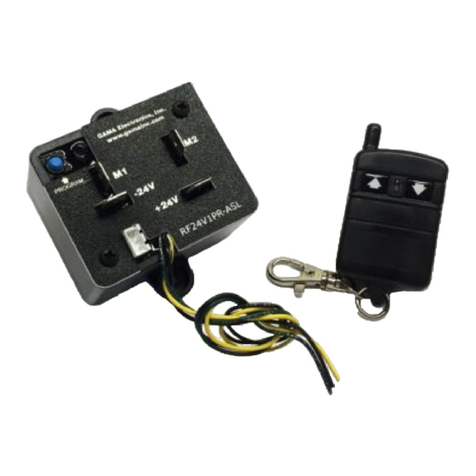
GAMA Electronics
GAMA Electronics RF24V-1PR-ASL instruction manual
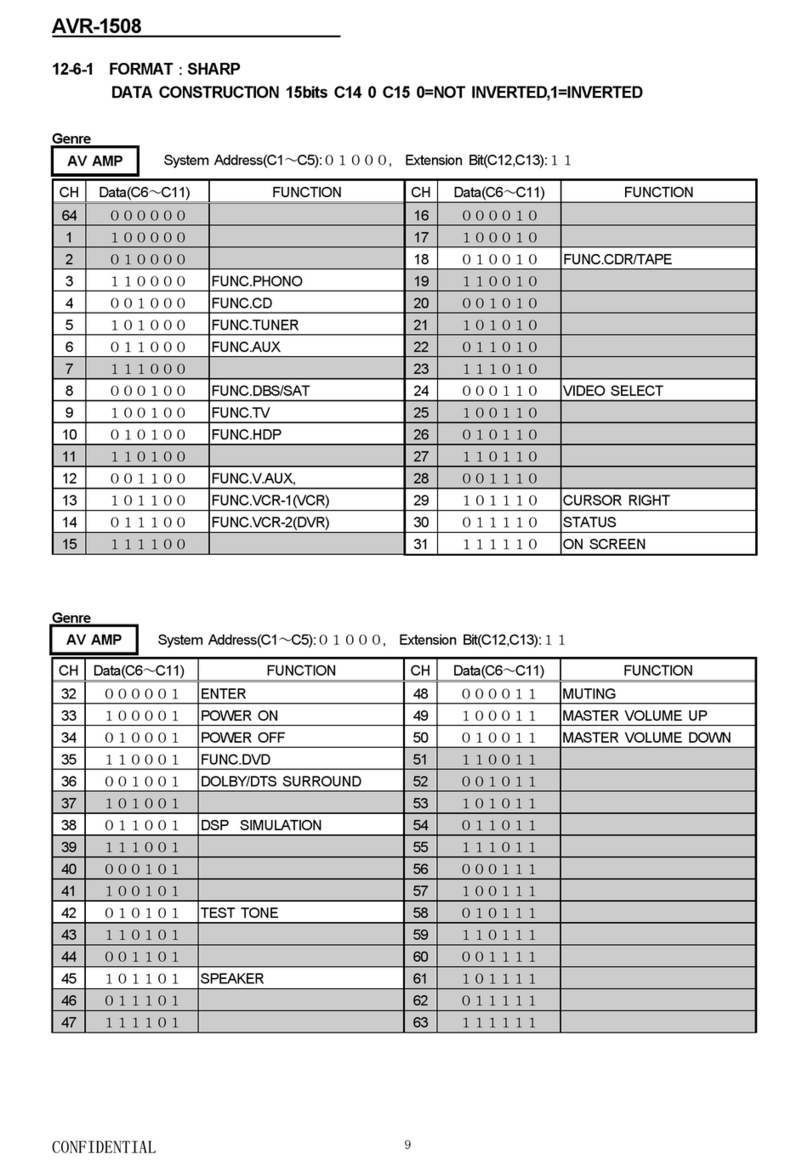
Denon
Denon AVR 1508 - AV Receiver Code List
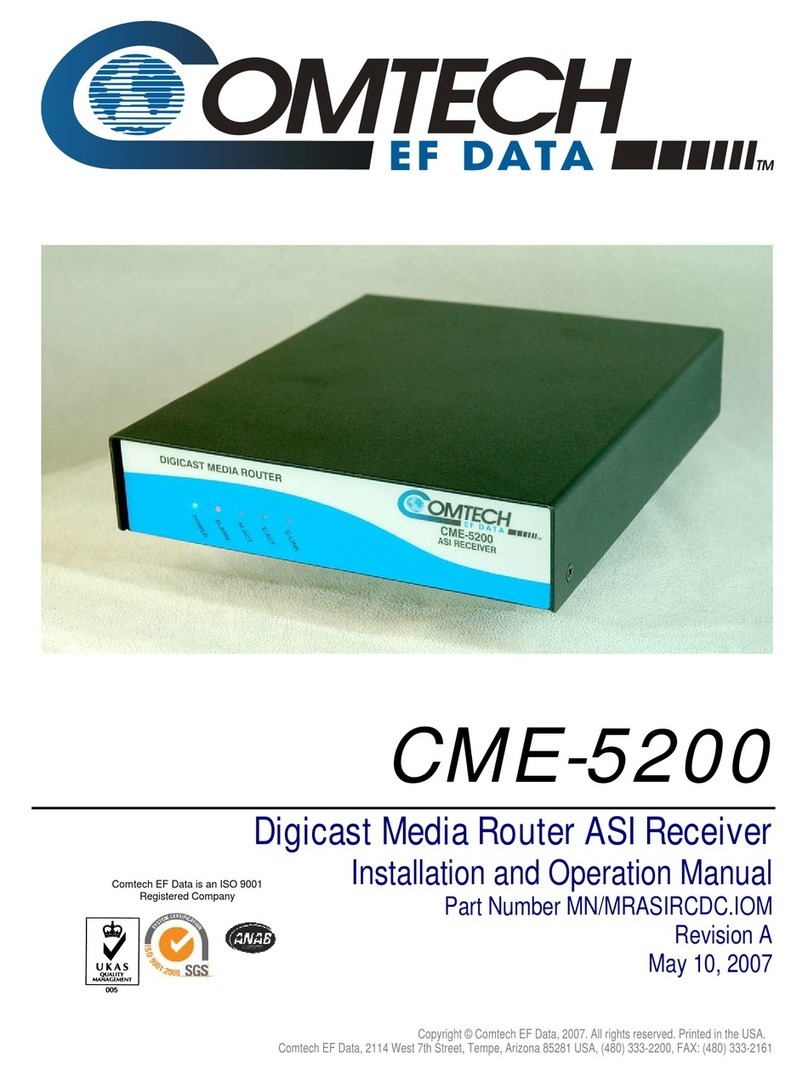
Comtech EF Data
Comtech EF Data CME-5200 Installation and operation manual

Hosa Technology
Hosa Technology drive IBT-402 user manual
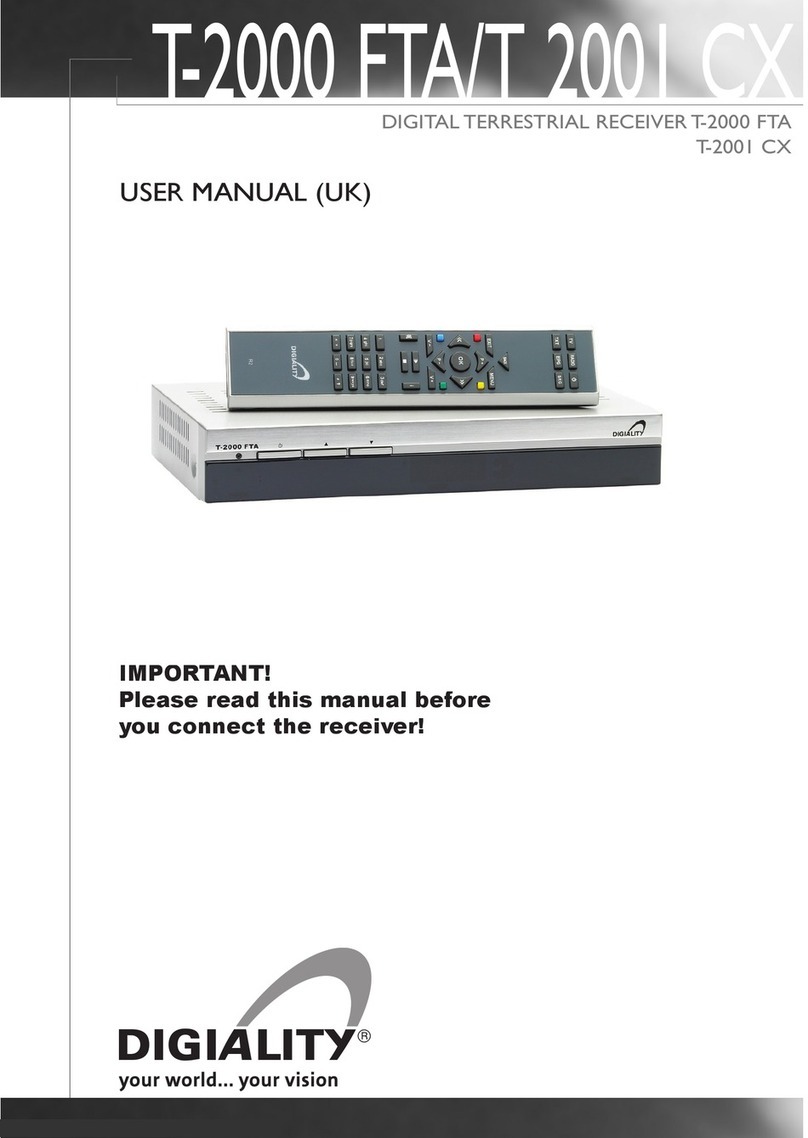
Digiality
Digiality T-2000 FTA user manual
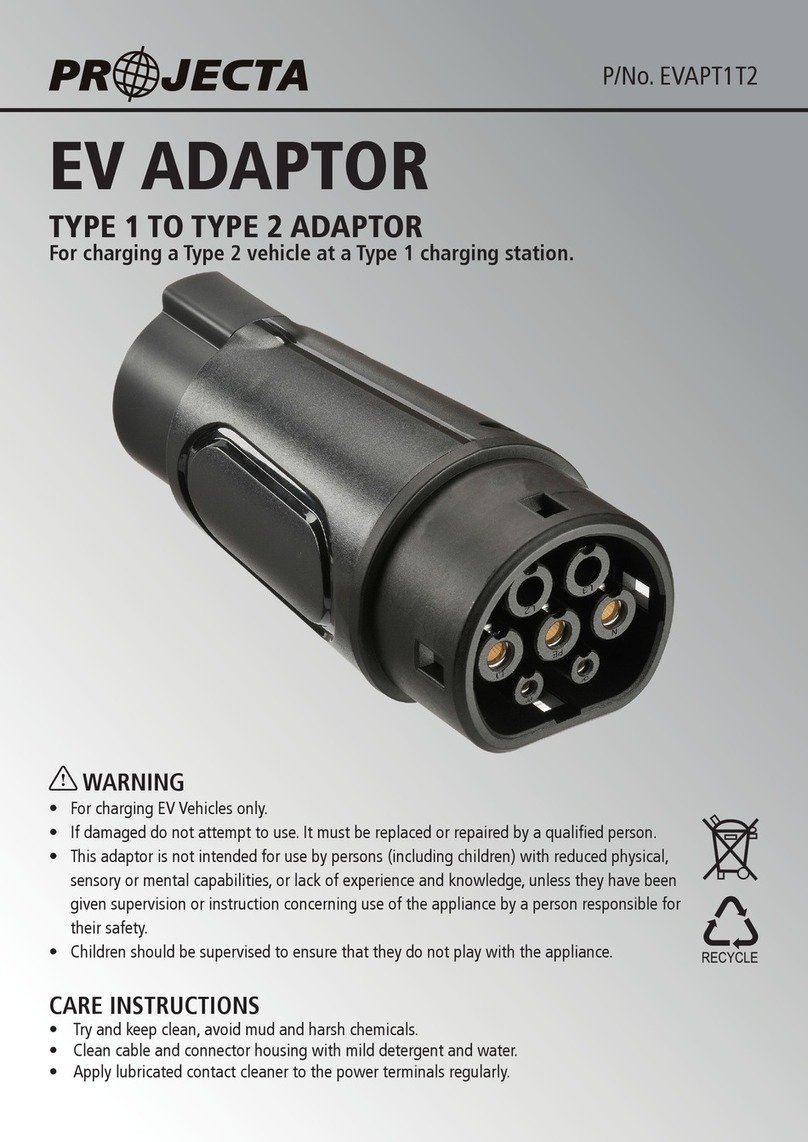
Projecta
Projecta EVAPT1T2 quick start guide
